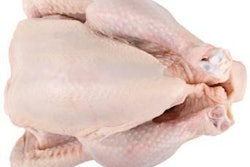The Tyson Foods fourth quarter 2012 earnings conference call had the confident air of a company headed into an economic boom, as executives ticked off balance-sheet improvements and growth projections, except like every animal proteins producer it faces a weak U.S. economy and $7-a-bushel corn prices in 2013.
Where does the $35 billion meat and poultry proteins company find the confidence to be up in a down economic environment? It starts with three years of improvement in its balance sheet, which Tyson’s Chief Financial Officer Dennis Leatherby calls a competitive advantage. “The improvements we have made over the last three years have provided us with a balance sheet that is a competitive advantage and a solid foundation for our strategic plan,” he said.
That strategic plan includes a greater focus on value-added products and international markets, the purchase of significant quantities of supplemental chicken on the open market, and a migration away from fixed-pricing of Tyson products.
Tyson’s ‘best year’ is new baseline
After stipulating that Tyson Foods is anticipating an incremental $600 million in feed ingredient costs in fiscal 2013, President and CEO Donnie Smith said he was confident the company would deliver offsetting operational and pricing improvements. “I think that fiscal 2013 EPS will be similar to the last couple of years,” he said, “and it is encouraging to know that we are off to a great start in Q1.”
Tyson’s fiscal year 2012 operating income was basically flat year-over-year at $1.248 billion, but Smith called it the company’s “best year” in light of the profitable performance in a tough operating environment. Adjusted EPS was $1.91, which is in line with EPS over the last three years.
While the company expects earnings to be flat in fiscal 2013 compared to the previous two years, Smith said earnings should grow at a rate of around 10 percent in 2014 and 2015.
Value-added and international segments
“Over the next three years, Tyson will accelerate its growth in value-added poultry and prepared foods and in its international business," said Smith. "As a result, you should expect to see top line sales grow between 3 percent and 4 percent annually. Our value-added sales should grow at twice that rate or at 6 percent to 8 percent. And the sales from international production should grow at twice that rate or 12 percent to 16 percent a year."
The company is counting on the higher margins in the value-added and international segments to fuel its future profitability.
Why Tyson is upbeat about China
While Tyson lost $90 million in its China business in 2012, the company believes the business will soon yield higher rates of return than its U.S. operations. The upside for now is in converting the supply of chickens from more expensive wholesale sources to birds grown in company-owned housing. Presently, 75 percent of chickens for the China business are sourced on the wholesale market, while only 25 percent are produced on company-owned farms.
“It’s all about getting as much of that chicken production as we can into company-owned housing as fast as we can,” said Smith. “As we bring on more company-owned housing it also allows us to move more of our mix into more desirable channels, which will also help reduce our losses."
With the changeover to company-owned housing, Tyson’s China business promises to yield low double-digit returns by 2015, according to Smith.
Buy versus grow strategy
One key to Tyson’s U.S. profitability amid the down economy and high feed costs is a strategy of supplementing its supply of chicken with outside purchases. The company is now purchasing about 60 loads of chicken (primarily breast meat) a week on the open market.
“The buy versus grow strategy reduces our exposure to the volatility in commodity pricing,” Smith explained. “As long as we are buying raw material – primarily breast meat – and we are not in a position of excess supply of the product, it allows us to better hold onto our price strings. The buy versus grow strategy allows us to be more effective in pricing discussions.”
The strategy also means Tyson – typically with no excess chicken on hand – sells less at reduced market prices.
Less fixed pricing
Tyson is also selling less meat and poultry in fixed-price arrangements, which helps insulate the company from commodity price swings. “Our annual fixed-price exposure will be in the single digits after the first of the year,” said Smith. “That is another reason for our confidence about the outlook for 2013.”
Tyson’s changing business approach
Smith provided the following thoughts on Tyson’s evolving approach to its business: “We are establishing a culture of lean thinking and operational excellence and continuous improvement. We are a better, safer, more dependable company,” he said.
“Tyson’s destiny is not to become a low-cost, commodity protein company. Our customers and our stakeholders need us to grow into a solution-providing food company. We’ve laid the foundation. We can never forget what got us to this point. But what got us here won’t get us there,” he concluded.

















